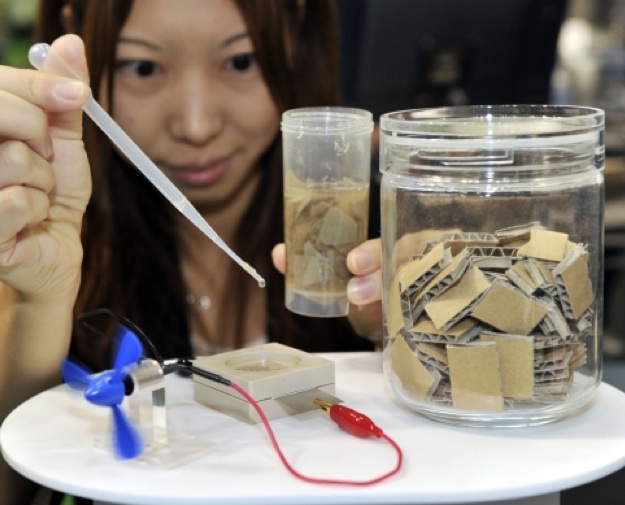
Electronics giant Sony has demonstrated a battery that runs on shredded paper, and produces water as a waste product.
At the Eco-Products conference in Tokyo, Sony had a group of kids put paper in a solution of water mixed with enzymes that break down the cellulose and generate current. In the demo, it powered a small fan.
Electronics giant Sony has demonstrated a battery that runs on shredded paper, and produces water as a waste product.
At the Eco-Products conference in Tokyo, Sony had a group of kids put paper in a solution of water mixed with enzymes that break down the cellulose and generate current. In the demo, it powered a small fan.
PHOTOS: Top 10 Disrtuptive Techs from the Last Century
 Sony’s spokespeople told Agence France-Presse that the mechanism is similar to the one used by termites to digest wood. In this case, though, the enzymes eat the paper and make electrons and hydrogen ions. The latter mix with air and produce water, while the electrons make a current just like any other battery.
Sony’s spokespeople told Agence France-Presse that the mechanism is similar to the one used by termites to digest wood. In this case, though, the enzymes eat the paper and make electrons and hydrogen ions. The latter mix with air and produce water, while the electrons make a current just like any other battery.
Biological-type batteries have been demonstrated before. In one case, it was used in a pacemaker, and Sony developed sugar-powered batteries back in 2007. The reason they haven’t been used widely is that they don’t -- yet -- produce the heavy duty power necessary to run most electronics for an extended period of time (though Sony says this one could power an mp3 player, it isn’t clear whether they mean something like a Zune or an iPod Touch. The latter is much more power-hungry).
The demonstration, however, shows that the technology is now compact enough to fit inside a small device, so the next step will be boosting the power output.
Water Converts Wood to Biofuel
If it works, it will be a welcome change from the current battery technology, which uses chemicals that are sometimes pretty toxic and for which recycling can be complicated. Even though the lithium-ion batteries aren’t classified as hazardous waste, throwing billions of batteries a year into landfills is a less-than-optimal solution from an environmental perspective.

 Previous page
Previous page Back to top
Back to top







